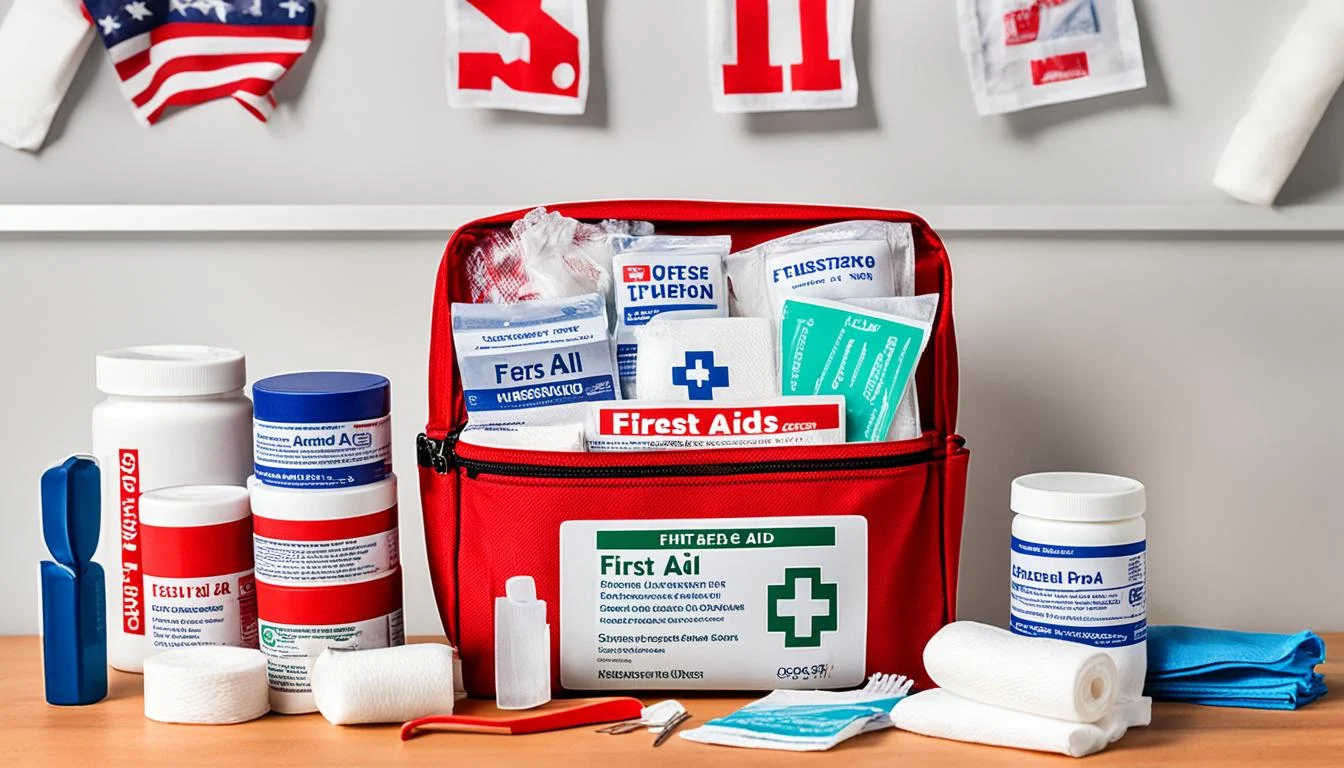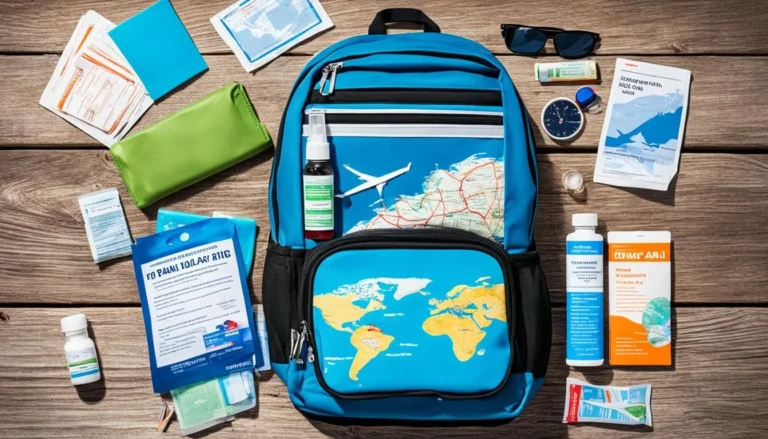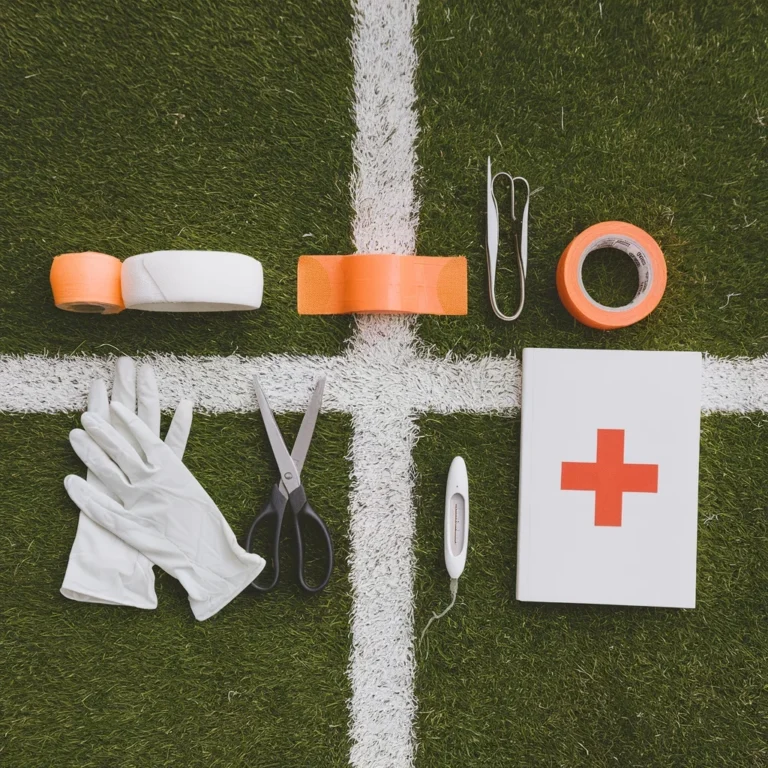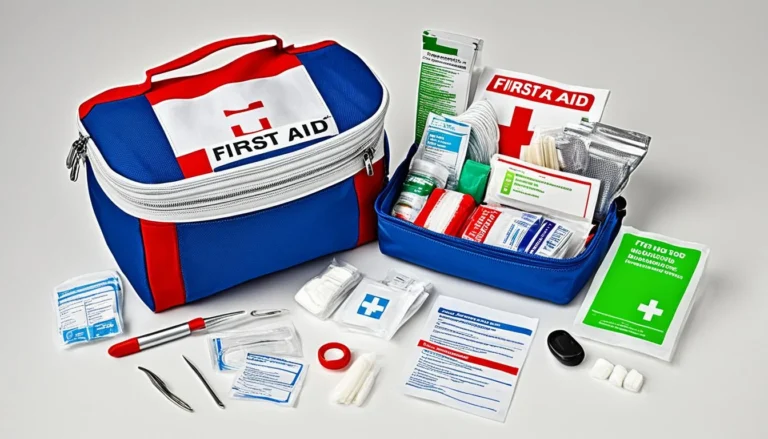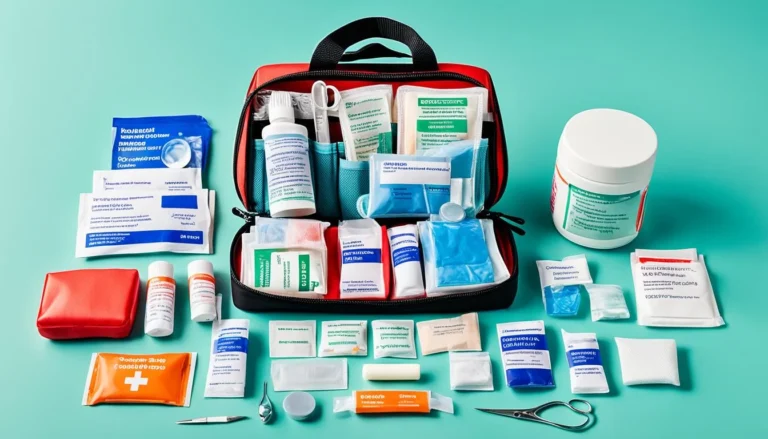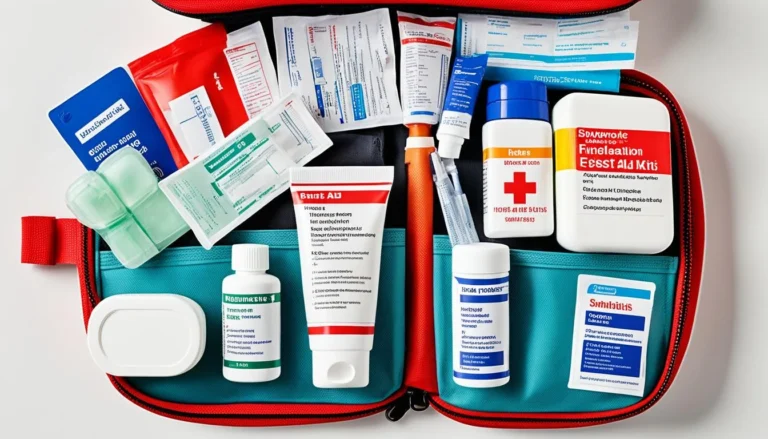What Should Be In A First Aid Box At School
Keeping students safe and healthy is key at every school. A well-stocked first aid kit is vital. It meets rules for first aid and prepares us for emergencies. This isn’t just about fixing small injuries quickly. It’s part of a school’s big job to look after everyone well. Following the rules makes our school a better, safer place.
Key Takeaways
- Comprehensive first aid kits are essential for school safety.
- These kits ensure first aid compliance with legal guidelines.
- Properly equipped kits support the wellbeing and emergency preparedness of students.
- Having appropriate first aid provisions is part of a school’s duty of care.
- A well-stocked first aid box helps in promptly addressing minor injuries.
Introduction to School First Aid Kits
School first aid kits are crucial for managing health in schools. They provide the means to respond quickly to emergencies. They help deal with minor injuries and stop them from getting worse. This is key for taking care of children’s daily scrapes or an unexpected allergic reaction. A well-stocked first aid kit is a must for handling emergencies in school.
The content of these kits may vary, but they follow certain guidelines. These guidelines ensure the kits are ready for common injuries. They equip schools with a standardised method for dealing with health issues.
Following these guidelines creates a safer environment for everyone at school. It aligns with the best practices of health care in schools. Being ready for first aid means schools can respond effectively to any situation. This makes dealing with emergencies in education better.
Legal Responsibilities for School First Aid
In the UK, schools must ensure the safety and wellbeing of everyone. This includes making sure they have enough first aid supplies and follow health and safety rules.
Duty of Care and Wellbeing
The idea of duty of care is very important in school safety. It means the school should do everything they can to prevent harm. This includes having first aid kits that are easy to get to and always full.
- First aid provisions should match the unique needs of each school.
- Training for staff must include how to deal with health crises.
- It’s vital to keep checking and updating first aid equipment.
Guidance from the Health and Safety Executive (HSE)
Schools have to follow the Health and Safety Executive (HSE) rules. The HSE focuses on having enough first aid supplies and making sure staff know how to use them.
Being HSE compliant means:
- Figuring out what first aid you might need through risk assessments.
- Making sure first aid kits are always easy to get to.
- Keeping first aid procedures and supplies up to date.
Following these rules not only keeps you legally right but also ensures your school is safe. This way, everyone knows they are well cared for.
Essential Items for a School First Aid Kit
Keeping students and staff safe means schools need the right first aid essentials. They should follow Health and Safety Executive (HSE) guidelines for standard medical supplies. This way, they can treat common injuries well.
Basic Medical Supplies
Basic medical supplies are crucial for every first aid kit. They help with everyday school injuries. This includes small cuts, needing immediate care, and avoiding more harm. These items are needed:
- Assorted plasters for minor cuts and grazes
- Sterile dressings for larger wounds
- Antiseptic wipes to clean wounds
- Scissors for cutting bandages
- Tweezers for removing splinters
- Eyewash for foreign particles in the eye
Specialised Equipment for Schools
Schools also need specialised equipment for certain injuries. This gear gets them ready for a variety of accidents. It includes:
| Specialised Equipment | Purpose |
|---|---|
| Adhesive tape | Securing dressings and bandages |
| Cushioning pads | Providing comfort and support for injuries |
| Instant cold packs | Reducing swelling from sprains and strains |
| Resuscitation face shield | Safe administration of CPR |
| Disposable gloves | Preventing infection and contamination |
The HSE guides help make sure schools are prepared. They suggest a mix of basic supplies and extra gear. This helps schools keep their first aid essentials up to a high standard, for a safer place to learn.
The Role of the First Aider in Schools
Having a certified first aider in schools is very important. They act fast during health emergencies. Their job is not only to give first aid. They also keep an eye on the situation and make sure the first aid kit is ready.
First Aid Training for Staff
It’s crucial for school staff to have training in emergency response. This training gives them the skills and the confidence they need. They learn both basic and advanced first aid. So, they can take good care of everyone at school. This makes sure emergencies are dealt with quickly and well.
- Basic first aid skills
- Advanced care techniques
- Use of specialised equipment
Responsibilities During School Hours
Staff have many jobs during school hours. A certified first aider does more than just give first aid. They make sure the first aid kits are ready and the equipment is working. They also keep track of everyone’s health and work with the emergency services when needed. This keeps the school safe and ready for any health issues.
| Tasks | Description |
|---|---|
| Medical Attention | Provide immediate care for injuries and health issues |
| Equipment Maintenance | Regular checks and restocking of first aid kits |
| Record-Keeping | Documenting health incidents and actions taken |
| Coordination | Engage with external emergency services when required |
What Should Be In A First Aid Box At School
It’s very important that a school’s first aid box has all the essential medical items. The Health and Safety Executive (HSE) gives good advice for a basic first aid checklist. You should adjust what’s in the first aid box to fit the school’s needs. This helps make sure you can respond well to any school emergency care.
- Sterile adhesive dressings in assorted sizes
- Triangular bandages for supporting limbs
- Crepe rolled bandages for securing dressings
- Safety pins to fasten bandages
- Sterile eyepads for eye injuries
- Gauze pads for cleansing wounds
- Single-use gloves
- Antiseptic wipes for cleaning wounds
- Thermometer to check body temperature
- Pocket mask for resuscitation
A well-planned first aid checklist makes sure everything needed is there. You should check and change the items as the school’s needs change. A completely stocked first aid box is essential for good school health care. It allows quick and effective help in school emergency care.
Additional Items for Specific School Needs
When schools plan activities and trips, first aid must be fully stocked. This makes sure everyone is safe and ready for any situation, even away from school.

First Aid Supplies for Sports Activities
School sports need special first aid kits. These should have things like cold packs, stretchy bandages, and creams for muscle injuries. Since sports can cause more injuries, we need to be ready to help right away.
Considerations for Extracurricular Trips
On school excursions, we must think ahead for what students might face. Special first aid kits should have things for travel sickness, bug bites, and to support broken bones. By being prepared in this way, we make sure students get the best care no matter the setting.
| Activity Type | Suggested Additional Supplies |
|---|---|
| Sports | Cold packs, elastic bandages, antiseptic ointment |
| Excursions | Motion sickness tablets, insect sting relief, compact splints |
Maintaining and Restocking the First Aid Kit
Looking after school first aid kits means making sure they’re always ready for an emergency. Having a set maintenance schedule helps a lot. This schedule should include regular checks and updating what’s inside. This way, we make sure there are no missing items when needed.
Create a Regular Check Schedule
Regularly checking the first aid kit is key to keeping it reliable. A good maintenance schedule includes weekly looks to see what’s been used up. Plus, a once-a-month thorough check helps fix any overlooked problems.
Use of First Aid Kit Checklists
To keep the first aid kit well-stocked, using checklists is a must. Checklists list every item, making it easy to see what’s missing. With routine checks using these lists, schools can make sure their first aid kit is top-notch for everyone’s safety.
Guidelines for Classroom First Aid Kits
Keeping on-site emergency care in classrooms is key for classroom safety. It ensures quick help for minor accidents. While not every class has a first aid kit, it’s vital to know what should be inside one if you have it.
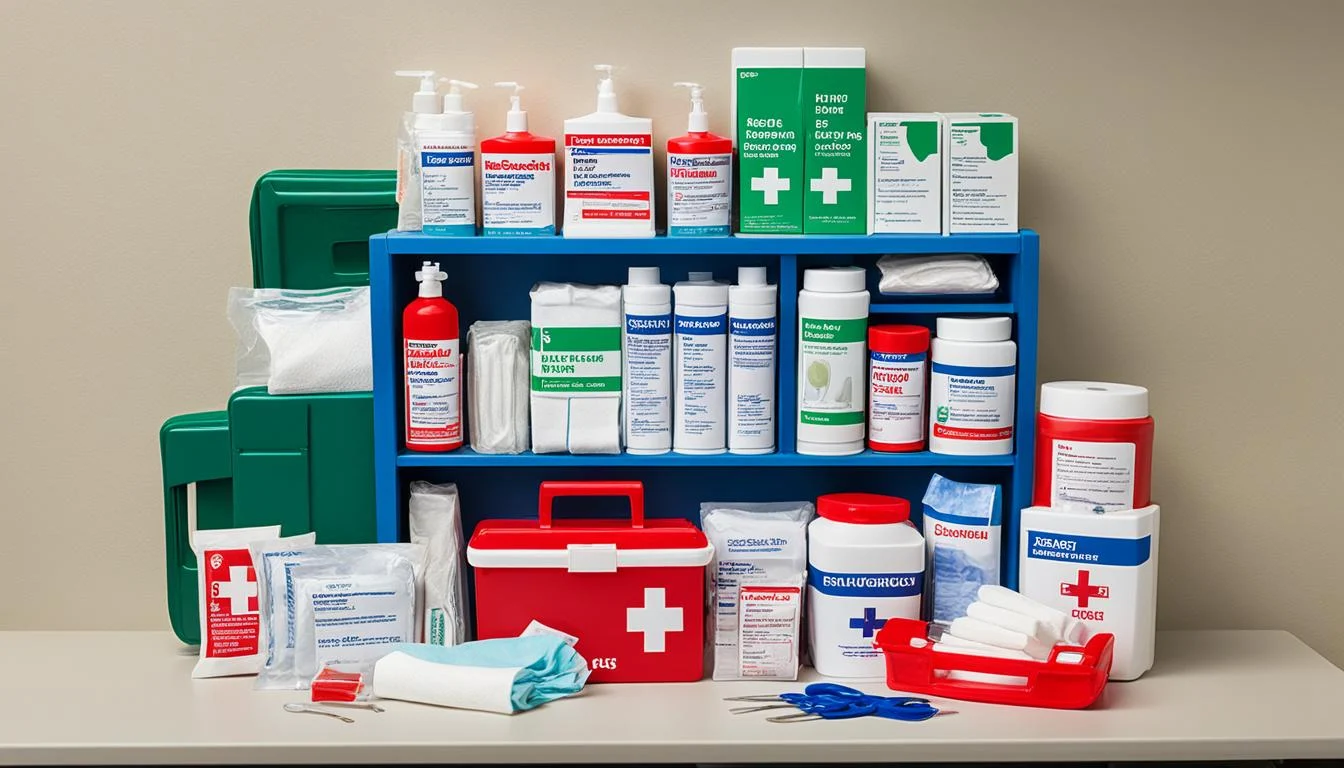
For a good classroom safety plan, keep a first aid kit up to date with emergency kit standards. Add items like adhesive bandages and antiseptic wipes to it.
- Adhesive bandages
- Antiseptic wipes
- Small sterile dressings
- Disposable gloves
- Adhesive tape
- Scissors
- Burn ointment
- Instant cold packs
Make a kit that fits your classroom’s needs and follows the emergency kit standards. This way, you offer prompt on-site emergency care. Keep it stocked regularly to be ready for any situation.
It’s also smart to track the kit’s items over time. Doing this keeps your classroom safe and healthy.
Below is an example of how to set up a first aid kit for school:
| Incident Type | Recommended Items |
|---|---|
| Minor cuts and grazes | Adhesive bandages, antiseptic wipes, small sterile dressings |
| Burns | Burn ointment, instant cold packs |
| Allergic reactions | Disposable gloves, adhesive tape |
By following these emergency kit standards, you keep classroom safety high. This ensures quick and effective help on site.
Standard First Aid Kit Contents Recommended by HSE
Following HSE guidelines helps schools handle injuries well. It’s crucial to have a well-stocked first aid kit. This kit includes protective equipment for maintaining hygiene.
Sterile Dressings and Plasters
Having sterile dressings and plasters is key. They protect wounds at the start and lower the risk of infection. It’s important to have different sizes available for various injuries.
| Item | Purpose |
|---|---|
| Sterile Dressings | Cover and protect open wounds to prevent infection |
| Plasters | Quickly cover minor cuts and scrapes |
Disposable Gloves and Safety Pins
Disposable gloves are essential for safety and hygiene. Safety pins come in handy for securing bandages. They are crucial additions for any first aid kit to meet HSE standards.
| Item | Purpose |
|---|---|
| Disposable Gloves | Maintain hygiene and prevent cross-contamination |
| Safety Pins | Secure dressings and bandages in place |
Schools meet HSE guidelines by including these items. This ensures they can treat injuries safely and effectively with the right protective equipment.
Customising First Aid Kits for Primary and Secondary Schools
Each school type has its own needs when it comes to first aid. They must have the right supplies to help their students. With the right supplies, first aid kits in schools can keep students safe and healthy.
Primary School Specific Items
In primary schools, younger students might get minor injuries like bumps and cuts. So, their first aid kits should have:
- Hypoallergenic plasters
- Small gauze pads and bandages
- Antiseptic wipes suitable for sensitive skin
- Cool packs for bruises
- Child-sized face masks
- Non-latex gloves
Secondary School Specific Items
In secondary schools, older students do more activities that could lead to different injuries. Their first aid kits need to have:
- Standard and large sterile dressings
- Sterile eye pads
- Triangular bandages
- Advanced antiseptics
- Specific items for handling sports injuries
- Items for lab-related accidents, such as burn dressings
Having the right first aid kit for each type of school is key to a safe school. These kits help give quick and good care, making schools safer places.
The Importance of a First Aid Room or Area
A dedicated first aid space in schools is vital. It ensures serious emergencies are handled properly. These areas are private and have extra supplies. They help schools be ready for any health crisis students might face.
Minimum Requirements for a First Aid Room
The Health and Safety Executive (HSE) lists what a first aid room needs. It must be easy to reach, well-lit, and stocked with medical items. It also must be clean and private for patient comfort.
Benefits of a Dedicated Area
Having a first aid room has several advantages. It gives a calm place for sick or hurt students to get help. It also keeps medical tools organised and close. This supports first aiders in their important work.

